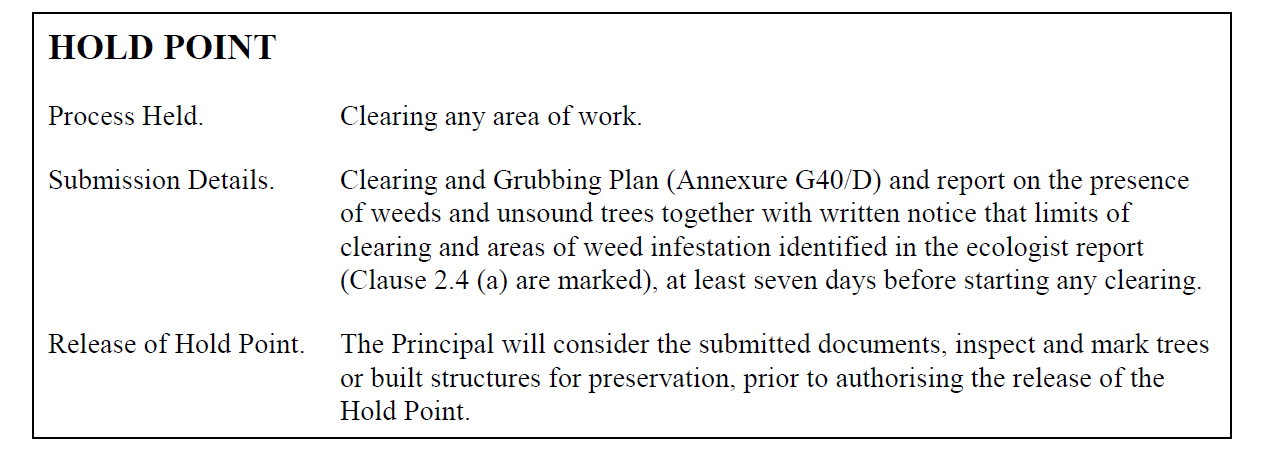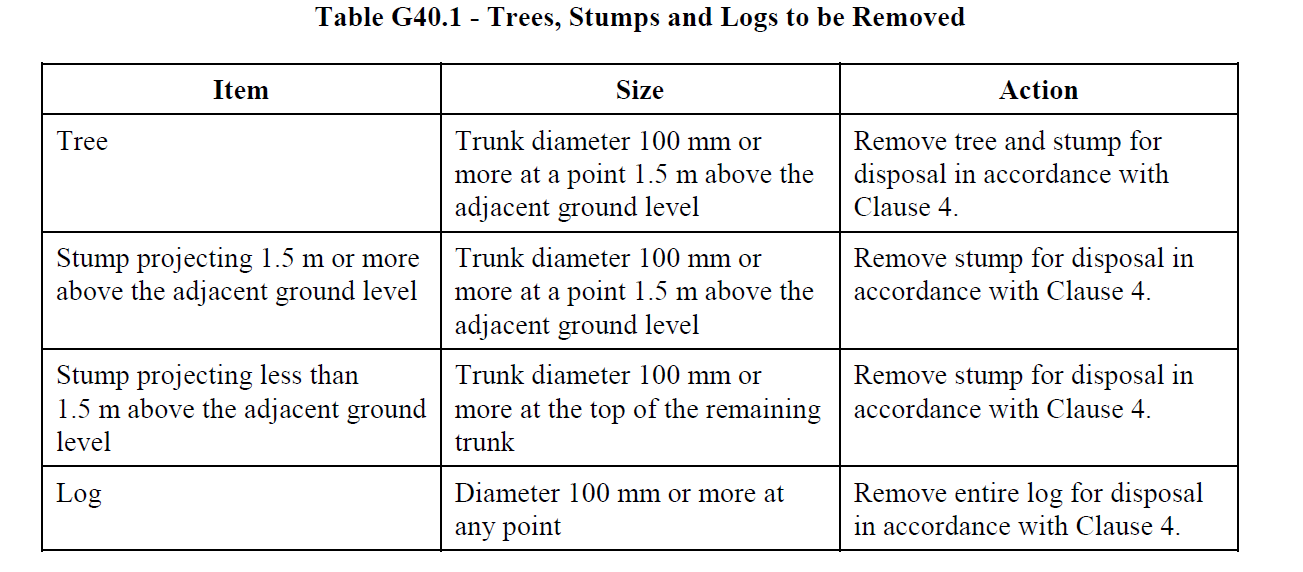Information
-
Inspection Title. Clearing and Grubbing. Ed1 / Rev1
-
Project Name: Tabulam New Bridge.
-
Location: BRUXNER HIGHWAY TABULAM
-
Contractor
-
Prepared by
-
Conducted on
Work Activity Record
2.4 CLEARING
-
Before clearing commences, identify the limits of clearing by clearly visible markers. Also provide a report which:<br>(a) includes a statement from an suitably qualified Ecologist that identifies the species and location of any weeds growing anywhere in the road reserve over the length to be cleared and grubbed;
-
(b) identifies all locations of threatened flora species and trees which have been marked or otherwise identified for preservation including actual or potential habitat trees identified for staged clearing; and
-
(c) lists any trees outside the limits of clearing which are unsound and likely to fall upon the roadway or onto private property.
-
Where possible, have areas within the assessed areas that do not need to be cleared to provide for construction activities are to be included as part of the exclusion zones and fenced accordingly.
-
Has the Hold point been released
-
-
Before commencing clearing and grubbing were all soil erosion and sedimentation controls required for this phase of construction must be installed in accordance with RMS G38
-
Were any idenified weeds removed and disposed of in accordance with the requirements of the local Council and DPI guidelines.
-
Has existing trees, grasses and other ground cover been retained within 15 metres of rivers, creeks <br>and watercourses and in all drainage lines until immediately before construction commences in the area. All trees in these areas must be felled manually, leaving grasses and small understorey species wherever possible.
2.1 AREA TO BE CLEARED FOR THE FORMATION
-
Has clearing been limited as far as reasonably practicable to that necessary to construct the Work Under the Contract.
-
Have Construction compounds, stockpile sites and the storage of materials been limited to within existing cleared areas, unless otherwise approved by the Principal.
-
Has the clearing Unless shown otherwise on the Drawings or restricted by exclusion zones, the area to be cleared for the formation is that which will be occupied by the completed formation plus a clearance of up to 4 m beyond tops of cuts and toes of embankments where the natural fall of the ground is towards the roadway and up to 2 m beyond the tops of cuts and toes of embankments where the natural fall of the ground either slopes away from the roadway or is level provided that the cleared area does not extend beyond the road reserve or private property boundaries.
-
Clear areas that will be occupied by ancillary earth features shown on the Drawings, including sediment basins and traps, open drains and diversion banks.
-
Has clearing outside the formation is to be avoided as far as reasonably practicable.
2.2 AREA TO BE CLEARED OUTSIDE THE FORMATION
-
Has clearing outside the formation is to be avoided as far as reasonably practicable.
-
No clearing of riparian vegetation or other construction activity, including parking of machinery<br>during periods of no work, is permitted beyond the area as defined in clause 2.1.<br>
-
<br>All trees, stumps and logs of the sizes listed below which are outside the area to be cleared for <br>the<br>formation as defined in clause 2.1 but which are considered by the Principal to be a potential <br>traffic within the hazard line shown on the Drawings must be trimmed or removed with a minimum of <br>disturbance to adjacent trees and other vegetation. The sizes of the trees, stumps and logs that <br>must<br>be removed are shown in Table G40.1.<br>
-
2.3 AREA TO BE CLEARED FOR BRIDGES
-
At bridges all trees and stumps and all built structures must be removed within the area specified in Annexure G40/A except:<br>(a) where shown otherwise on the Drawings; or
-
Trees within 10 metres of the centreline of the bridge and within 5 metres of the bank of any stream or other waterway must be cleanly cut off between 300 and 600 mm above the adjacent ground level so that stable vegetation is retained on the banks.
-
(b) marked to be preserved; or
-
<br>(c) was within 5 metres of the bank of any stream or other waterway.<br>
-
<br>(c) was within 5 metres of the bank of any stream or other waterway.<br>
-
Have trees outside this area but having branches overhanging the bridge had their branches lopped to be 3 metres clear of the bridge.
2.5 CLEARING OF BUILT STRUCTURES
-
Existing redundant drainage and concrete structures must also be demolished, removed and the materials disposed of offsite in accordance with the requirements of this specification and RMS G36.
-
Have works carried out under cl 2.5 been recorded on the Work-As-Executed Drawings.
3 GRUBBING
-
Have grubbing operations been carried out both to a depth of 0.5 m below the natural surface and 1.5 m below the top of the Selected Material Zone.
-
Have holes remaining after trees and stumps have been grubbed and redundant drainage, utilities and other structures removed must be backfilled promptly with sound material to prevent the infiltration and ponding of water.
-
Where the native vegetation on site is insufficient to provide the quantities of mulch needed during landscape planting, all native trees removed during clearing and grubbing must be mulched and stockpiled.
-
In the area defined in Clause 2.2 the final 50 mm of backfilling must be topsoil and the area must be vegetated within 7 days of removal of the stump. Topsoil and vegetation must comply with RMS R178.
4 PRODUCTION AND STOCKPILING OF MULCH
-
Are stockpile sites located away from drainage lines and watercourses and must be arranged to minimise damage to natural vegetation and trees.
-
Where the native vegetation on site is insufficient to provide the quantities of mulch needed during landscape planting, all native trees removed during clearing and grubbing must be mulched and stockpiled.
G22 Safety and G36 Environmental
G22 SAFETY
-
Have operators demonstrated their competence to operate the plant/equipment to the satisfaction of the contractor. <br>
-
Has a SWMS been developed.
-
Is each and every item of plant being used for its designated and intended purposes.
-
Have the attachments for plant and processes been approved and used in accordance with their design and purposes.
-
Is the correct PPE being worn
-
Were any unsafe practices observed. <br>
-
Good safe practices observed.
G36 ENVIRONMENTAL
-
R44 Cl 1.7 Were erosion and sediment controls in place prior to the removal of any topsoil.
-
Are Erosion and Sediment controls measures being installed and maintained.
-
Has mud been prevented from being deposited on roadways.
-
Have any environmental incidents or potential incidents been observed.
-
Good environmental procedures observed.
Compliance and Follow-up action.
-
Is the activity compliant.
-
Surveillance Officer
-
NCPN or memo number.
-
Follow up action
-
Product Non Conformance
-
System Non Conformance
-
Contractor generated NCR
-
Contractor generated a CAR
Matters arising
-
NCPN no
-
Contractors NCR no
-
CAR no
-
Closed out.
-
RMS representative's name








